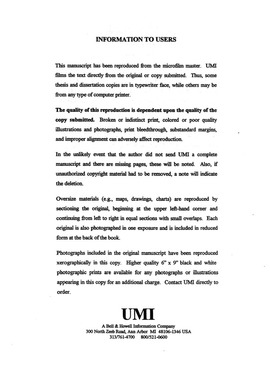| dc.contributor.advisor | Long, Huey B., | en_US |
| dc.contributor.author | Barnes, Karen Lynne. | en_US |
| dc.date.accessioned | 2013-08-16T12:30:19Z | |
| dc.date.available | 2013-08-16T12:30:19Z | |
| dc.date.issued | 1998 | en_US |
| dc.identifier.uri | https://hdl.handle.net/11244/5718 | |
| dc.description.abstract | The curiosity materials, based on Berlyne's theory of epistemic curiosity, included ten psychological experiment accounts and participants rated three responses: (1) how surprising or unexpected the results were; (2) how valuable or useful the information was; and (3) how strongly they wanted to know more about the experiments. Statistically significant and positive associations exist between (1) SDLR and desire for knowledge; (2) SDLR and perceived valuel and (3) perceived value and desire for further knowledge. | en_US |
| dc.description.abstract | The situational variables of surprise and perceived value were the best predictors of curiosity about psychological research. It was concluded that perceived value represents an extrinsic motivational component for the intrinsic need for knowledge, or curiosity. A pattern of decline in curiosity scores among progressive educational levels exists for the sample and suggests that schooling may have a negative effect on curiosity. A moderate positive association exists between SDLR and subject-matter interest suggesting the possibility of an intrinsic orientation to learning. | en_US |
| dc.description.abstract | The purpose of the exploratory study was to examine the relationship between curiosity and self-directed learning readiness in a sample of adult learners. Specifically, the study was designed to address two problems: the association between self-directed learning readiness (SDLR) and curiosity; and the association among nursing students' educational level, SDLR, and curiosity. | en_US |
| dc.description.abstract | Self-directed learning and curiosity have been described in the literature as desirable characteristics of the adult learner. These characteristics are thought to contribute to success in the development of lifelong learning. A high degree of curiosity was one of eight characteristics of a highly self-directed learner identified by Guglielmino (1977/1978). | en_US |
| dc.description.abstract | This research was based on a cross-sectional design comprised of a convenience sample of 170 generic and career ladder nursing students enrolled in an accredited baccalaureate nursing program. Data used in this study were obtained from two sources: direct request from the subjects, and the institution's academic records. Guglielmino's (1977/1978) Self-Directed Learning Readiness Scale (SDLRS-A) was used to measure readiness for self-directed learning and Rossing's (1978) curiosity materials were used to measure curiosity (desire for knowledge). Demographic and biographical data for age, sex, marital status, ethnicity, and educational level were obtained. | en_US |
| dc.format.extent | ix, 187 leaves ; | en_US |
| dc.subject | Adult learning. | en_US |
| dc.subject | Curiosity. | en_US |
| dc.subject | Education, Educational Psychology. | en_US |
| dc.subject | Health Sciences, Education. | en_US |
| dc.subject | Education, Higher. | en_US |
| dc.subject | Nursing students Psychology. | en_US |
| dc.title | Curiosity and self-directed learning readiness among a sample of baccalaureate nursing students. | en_US |
| dc.type | Thesis | en_US |
| dc.thesis.degree | Ph.D. | en_US |
| dc.thesis.degreeDiscipline | Department of Educational Leadership and Policy Studies | en_US |
| dc.note | Major Professor: Huey B. Long. | en_US |
| dc.note | Source: Dissertation Abstracts International, Volume: 59-09, Section: A, page: 3343. | en_US |
| ou.identifier | (UMI)AAI9905634 | en_US |
| ou.group | Jeannine Rainbolt College of Education::Department of Educational Leadership and Policy Studies | |
